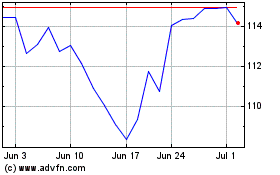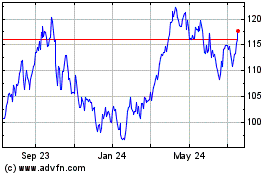By Christopher M. Matthews, Rebecca Elliott and Sarah McFarlane
The global oil-and-gas industry remains under extreme financial
pressure as demand for fossil fuels rebounds slowly after being
crushed by the coronavirus pandemic.
Some of the largest western oil companies including Exxon Mobil
Corp. and Royal Dutch Shell PLC signaled this week that key parts
of their business continued to struggle through the summer and
early fall, which will weigh down the third-quarter results they
are set to report in coming weeks.
Exxon warned Thursday that parts of its business continue to be
unprofitable, even as the company performed better than in the
second quarter. The Texas oil giant said it expected earnings from
its oil production unit to improve by as much as $1.8 billion from
the second quarter, but that its natural gas sales and its refining
business may lose more money. Analysts forecast a quarterly loss of
more than $500 million when the company reports on Oct. 30, which
would mark its third consecutive quarter in the red.
Shell said Wednesday it would cut up to 9,000 jobs in a broad
restructuring, and warned it was also poised to report poor third
quarter earnings, including a second consecutive quarterly loss in
its oil-and-gas production business. The planned job cuts follow
similar moves at peers including BP PLC and Chevron Corp. to rein
in costs amid the pandemic. Exxon has said it is conducting a
workforce review, which may lead to layoffs.
This year's lousy oil-and-gas earnings have turned off many
investors, who remain unenthusiastic about the companies despite a
modest rebound in crude prices from the historic lows of this
spring. A stock index of U.S. oil-and-gas companies is down about
55% in 2020 even as the overall stock market is up slightly.
Exxon's shares are down around 50% so far this year, while Shell's
are down about 58%.
U.S. benchmark oil prices remain around $40 a barrel, levels too
low for most exploration and production companies to turn a profit,
and smaller, independent players continue to face a struggle for
survival. On Wednesday, Houston-based shale driller Oasis Petroleum
Inc. filed for chapter 11, joining at least three dozen other North
American oil-and-gas producers in seeking bankruptcy protection
this year, according to law firm Haynes and Boone LLP.
"Due to historically low global energy demand and commodity
prices, we determined that it is best for Oasis Petroleum to take
decisive action to strengthen our liquidity and overcome the
headwinds now challenging both our company and industry," Oasis
Chief Executive Thomas Nusz said in a statement.
As the number of global Covid-19 infections continue to rise,
the return of restrictions that could reduce the number of cars on
the road and overall economic activity is leading to market
pessimism that oil demand will take a long time to recover.
Russia's energy ministry has said it doesn't expect a fast
recovery, while Vitol Group, the world's biggest independent oil
trader, said earlier this week it doesn't expect oil prices to rise
until 2021.
"The demand side of the equation will continue to be under
threat during the fourth quarter of the year, with Covid-19 cases
rising at an alarming rate, notably in Europe, which has already
imposed new restrictions to curve down the number of cases," said
Paola Rodriguez-Masiu, an analyst at Rystad Energy.
Rystad expects around 150 additional North American oil and gas
producers to file for bankruptcy by the end of 2022 if crude prices
remain around $40 a barrel.
The U.S. is now generating less than 11 million barrels of oil
daily, down from around 13 million barrels a day early this year,
Energy Information Administration data show. Two-thirds of
oil-and-gas executives who responded to a recent survey by the
Federal Reserve Bank of Dallas said they think U.S. oil production
will never fully recover.
Meanwhile, domestic consumption of gasoline and distillates
including diesel remains depressed, down roughly 9% from a year
ago, according to the EIA. That is weighing on refiners such as
Marathon Petroleum Corp., which said Wednesday that it was laying
off some 2,000 employees. Many of those cuts are tied to the
company's recent decision to keep two of its refineries idled
indefinitely. In all, Marathon Petroleum is cutting around 12% of
its jobs, excluding roles at its Speedway gas station chain, which
7-Eleven Inc. has agreed to buy.
For major oil companies with large liquefied natural gas
businesses, analysts expect weaker margins. LNG is sold via
long-term contracts where prices are often linked to oil with a
time lag of 3 to 6 months. That means the fall in oil prices
earlier this year only reached LNG during the third quarter.
"The macro environment certainly was very difficult and
profitability will have deteriorated in refining and LNG," said
Irene Himona, an analyst at Société Générale, who expects another
tough quarter for major oil companies.
Longer-term doubts are also clouding the industry's outlook as
it contends with competition from renewable energy sources, the
prospect of tightening government regulations and the increased use
of electric vehicles. BP said in September that global oil demand
could have already peaked and that it would potentially never
recover to pre-pandemic levels.
BP, Shell and other major European fossil fuel companies have
said they plan to invest heavily in renewable energy over the next
decade. Exxon, Chevron and most U.S. shale companies remain
committed to oil and gas.
Dan Pickering, chief investment officer of Pickering Energy
Partners LP, said that the industry has lost some investors over
concerns about the energy transition, even though the world will
need large amounts of oil and gas for decades to come.
"It has been a slow-growth business for a long time. It may turn
into a no growth to a declining business for a long time," Mr.
Pickering said.
Still, some executives are hopeful that the reduced investment
in oil and gas production this year will result in higher oil
prices in future. Total SA has drawn up a 10-year investment plan
based on a $50 a barrel price for the Brent crude oil benchmark. On
Thursday, Brent oil traded for around $41 a barrel.
"We are at $40 in the middle of a huge crisis where we have seen
a big oversupply and a huge lack of demand," Total Chief Executive
Patrick Pouyanne told investors this week. "I am sure that in two
to three years we will see higher prices and forget like we have
done in the last five years," he added.
Write to Christopher M. Matthews at
christopher.matthews@wsj.com, Rebecca Elliott at
rebecca.elliott@wsj.com and Sarah McFarlane at
sarah.mcfarlane@wsj.com
(END) Dow Jones Newswires
October 01, 2020 12:47 ET (16:47 GMT)
Copyright (c) 2020 Dow Jones & Company, Inc.
Exxon Mobil (NYSE:XOM)
Historical Stock Chart
From Mar 2024 to Apr 2024

Exxon Mobil (NYSE:XOM)
Historical Stock Chart
From Apr 2023 to Apr 2024
